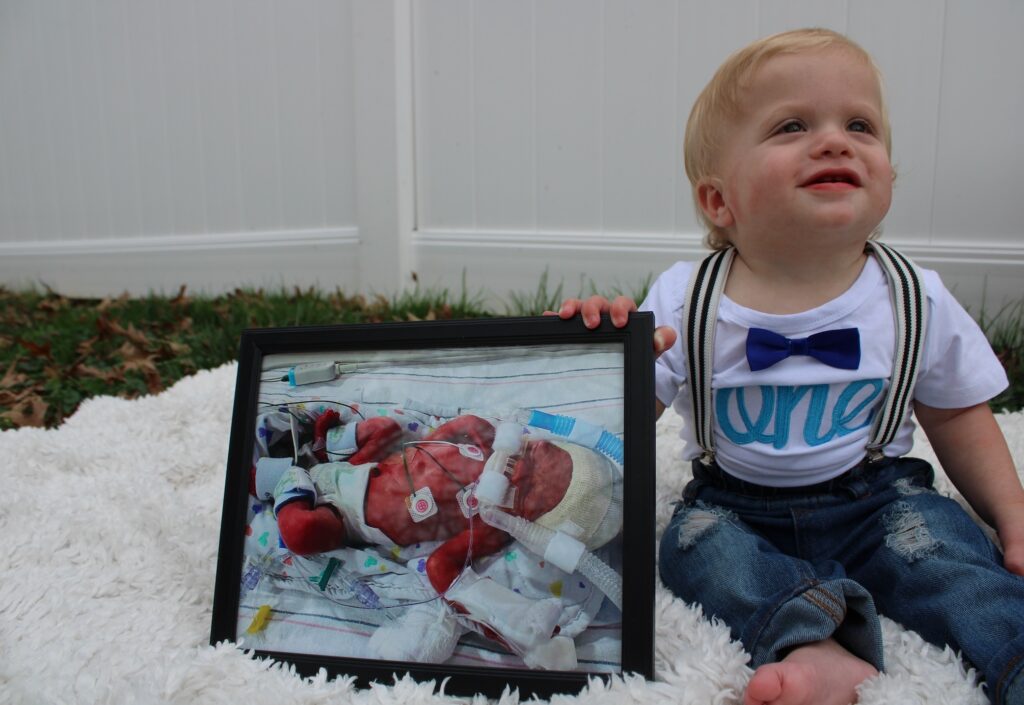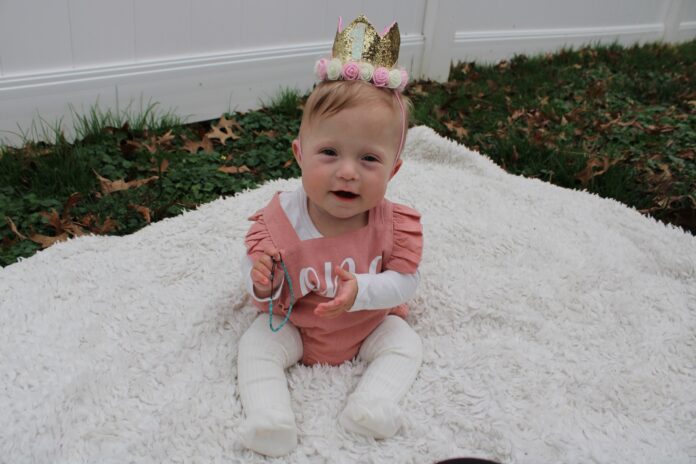On Nov. 11, 2021, I spent most of the day in a hospital bed on the high-risk maternity unit at Abington Hospital, trying in vain to get my preeclampsia-induced blood pressure down with a concoction of Calm app meditations and mindless Netflix movies. Finally, after about my 10th pressure check that day, the nurse told me to call Ashlee back to the hospital. It was time to meet our twins, nearly three months early.
Memories formed in times of panic are tricky. All I recall are snippets of those hours before the C-section: stealing ice chips to satiate my burning hot mouth, signing paper after paper that I didn’t care to read, the bizarre sensation as the nurses scrubbed and rescrubbed my stomach in prep. In the OR, I remember focusing on the absurdity of the fact that I went from being alone in the giant, overly lit room to having about 50 people (literally) bustling about in a matter of seconds, like a race crew. When the babies were born, I was struck by how red August was as they rushed him around to meet us before he was whisked away to be worked on, curiously pondering that and my ongoing preoccupation at a misplaced IV in my hand — probably purposely instead of dwelling on the fact that we didn’t hear Avery cry when she came out, nor did we get to see her.
Hours later, after both babies stabilized and I inhaled a hefty collection of Saltines eaten under the influence of heavy drugs, I was wheeled down for our first official meeting. Again, my mind wasn’t where it should be; I was perplexed mostly about how I could get my arm at an angle to reach through both babies’ isolettes, but especially focused on when I would get that cheeseburger Ashlee promised me.
Looking back one year later, I think I was in some semblance of shock. The morning of Nov. 11, I was under the impression I’d be cooling my jets in the hospital for weeks to let the babies grow as long as possible; and by just after 9 p.m., they were in this world, barely weighing 4 pounds together.

We didn’t know what it was like to be NICU parents, to be parents to twins, to be parents to babies whose very existence we had been told multiple times by the doctors now listening to their heartbeats wasn’t going to happen. We didn’t know how to change a micro-preemie diaper or how to do kangaroo care or how to take a temp on a baby whose skin wasn’t fully formed. We didn’t know a good oxygen saturation rate from a bad one, and what the blood pressure for an 18-ounce baby should be. I didn’t know how to pump, Ashlee didn’t know how to be there simultaneously for a family that had suddenly grown to five. We felt like we didn’t know how to be parents to these babies at all.
Avery was on a ventilator and, we know now, in far worse condition than our minds then would have allowed us to understand. At the time, though, it was an exercise in self-protection that we blocked out the world of uncertainty and the “we don’t knows” that were in front of our faces and focused just on the task ahead: meet the babies, text the family, get some food, get a little sleep, come back for a visit. And, eventually, that rote, mindless drudgery got us through, from adjusting to life back at home with a 3-year-old, from Avery’s transfer to a children’s hospital in Delaware, from getting used to having babies in two different states, from August’s release in January and up until Avery’s release in April.
We relied on our tried and true strategy of “just do it” when our house became full: Learn how to manage a G tube; go to appointment after appointment; new diagnosis? Got it; block out the double screaming so you can make the bottles, change the diapers, pack the lunches. It’s fine! We became a master class in taking it one day at a time, one hour at a time, one damn minute at a time.
And somehow, all of those minutes, those hours and those days have gotten us here, one year later. Each of those minutes that added up gradually taught us how to be August and Avery’s parents — even when we felt like we were failing, we were learning.
Every time we sat in on rounds in either NICU, we felt dizzy from the medical lingo and the acronyms, so we got to Google after the nurses and doctors left and learned the difference between bradycardia and tachycardia, what a central line does and, admittedly on my part, what “rounds” even are. And the next time, we were just a smidge more prepared. My hands were shaking the first time I had to insert a nasogastric tube into Avery before her release, but when I actually got it without even a scream on her part, I felt on top of the world. When she did come home, the infant screaming in our house was truly unbearable at times; I have hid in the bathroom, on the stairway, on my front steps more times than I can count to slow my breathing and stop my tears of frustration! But after some time, I started to be able to tell Avery’s hungry cry from her bored one, or notice that August’s eyes get red when he’s tired and needs a nap. The decibel level in my house is still rather unhealthy often, but I feel like I’ve gained back just an ounce of control over it; instead of the helpless feeling of drowning in a very angry ocean all of the time, it’s now more like we’re just steering a ship (full of overly emotional children!) through some choppy waves. It’s tough, but we’ve done it this long, so that ship must be headed in the right direction.
Each of those days that we took one at a time has added up to create a roadmap to parenting — that we now rely on for direction. Early on, we drew hope by focusing just on what was right in front of us; now, we’ve done that for so long, that we’re able to draw hope by that summation of those days. For instance, Avery’s physical therapy progress: at just about a year old, she still hasn’t been able to roll over from her back, let alone crawl or cruise the furniture like her twin brother. We work with her multiple times every day on exercises and stretches to help get her there, and it’s an extremely slow and painstaking process. Focusing just on one day, comparing how she held herself up in tummy time for only three seconds today, compared to five yesterday, or how she put weight down through her legs fleetingly last week but hasn’t since, could barely give us a glimmer of hope. Instead, every time I get pessimistic, I try to remember how far she’s come: When she started PT in June, she didn’t even have enough strength in her hands to grasp items and could barely hold her head up; now, she sits unsupported with better posture than most adults I know and can hold toys bigger than her. We’ve gotten so used to focusing on small, daily wins over the last year, but enough of those have added up that we can finally start to really look at the bigger picture.
And for the twins, that picture really is astounding.

August was 2 pounds, 15 ounces when he was born and is now approaching 19 pounds. The skin and bones he once was couldn’t be farther from today: a ball of chub with a ton of wispy blonde hair who’s almost in 18-month clothes. He’s finally on the growth charts for his actual (not adjusted for prematurity) age (and his giant head has him in the 90th percentile for head circumference!). He is the definition of a wild child: Since the moment he started to be able to roll and later crawl, we haven’t been able to get him to sit still. With no fear at all, he tries to head dive off of any couch or chair he’s on and is *this close* to walking any day now. He loves his independence and exploring on his own, so much so that we often lose track of him as we’re busy tending to his older brother and younger sister and find him stuck under furniture, behind doors and in other hilarious predicaments. He has a smile for literally anyone and anything (most especially his older brother and his dog), but his favorite thing in the world is certainly food. The tiny little being we took weeks trying to teach to latch onto a bottle now shovels whole waffles, pieces of pizza and anything that’s not nailed down (including off of other people’s plates) into his mouth.
Avery is the polar opposite of August, on many levels. Separated at birth by just two minutes, she started life about a third of his size: 1 pound, 2 ounces. She’s now almost 13 pounds and, while this 1-year-old is still in 6-months clothes, she doesn’t even faintly resemble the 11-inch baby bird she looked like when she was born. As carefree and fearfree as her twin is, she is much more of an observer, one to sit back and watch with bemused judgment as her brothers joyfully headbutt one another.
Her guarded, timid nature is surely owed, in part, to her inauspicious start to life. During her five months in the NICU, she battled diagnoses including hydrocephalus, pulmonary hypertension, collapsed lungs, and a double intestinal perforation. Apart from a large scar on her belly, some on her legs and a really funky hairline around the scar on her skull from brain surgeries, her NICU battle scars are less physical and more emotional. As much as her therapies are meant to strengthen her muscles and help her play catch-up physically, babies who had such early trauma like she did also need a lift in developing their confidence and trust in those around them, things that come naturally to babies born under different circumstances. That’s why we make sure to celebrate every single small win because we see how incredibly hard she works for each. We just about threw a neighborhood block party a few weeks ago when she rolled over from her belly to her back for the first time! And while the trauma of her little life has left an imprint, it hasn’t dampened her spirit: I’ve never understood the phrase “a smile that can light up a room” until I saw hers.
A year ago, I could not even have envisioned what that smile would look like; at that time, Ashlee and I purposely didn’t think too far ahead, or talk about what the babies would look like, be like or act like because a start like they had makes one realize that each day isn’t truly guaranteed. But looking back, I wish that we had made more room for hope; seeing the past year from this side, I think hope would have allowed us to take more heart in the small moments that we likely missed — what Avery’s first smile looked like or how August reacted to his first bath — because we were so mired in the worry.
So, this year on Nov. 11, we wanted to share some of that hope we didn’t have with other families. We took the twins back to the NICU to visit with the nurses and docs who cared for them and drop off care packages for the families who will be spending the next days, weeks or even months in the position we were last year. While we filled the bags with tissues, hand sanitizer, baby books and other items we could have used during our NICU days, we hoped the most important part was the note we included. We wanted to share all that the twins have achieved over the last year to show those families that, even though it may not look or feel like it today, those tiny, fragile babies in the isolettes in front of them won’t always be so.
Even though we couldn’t see the road ahead in those early days, it was always there. We just had to take it one step at a time.


